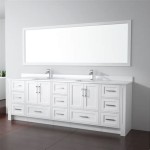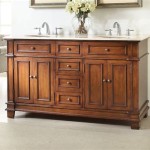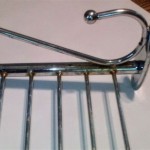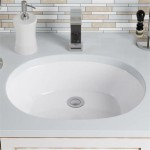Should You Paint Your Bathroom Vanity? A Comprehensive Guide
A bathroom vanity often serves as the focal point of the room. Over time, vanities can show wear and tear, appearing dated or simply clashing with updated décor. Painting a bathroom vanity is a popular DIY project that can drastically change the look and feel of a bathroom without a complete remodel. This article will explore the benefits, drawbacks, and factors to consider when deciding whether to paint a bathroom vanity.
Benefits of Painting a Bathroom Vanity
Refreshing the appearance of a bathroom is a primary motivator for painting a vanity. A fresh coat of paint can transform a dated or worn piece into something that looks brand new. This can be achieved at a fraction of the cost of replacing the entire vanity.
Painting also offers unparalleled customization options. Homeowners can select from a vast array of colors and finishes, allowing them to perfectly match the vanity to their existing bathroom décor or create a bold statement piece. This level of control is often not possible with pre-fabricated vanities.
Finally, painting a bathroom vanity can increase the value of a home. A well-maintained and stylish bathroom is an attractive feature for potential buyers. A fresh coat of paint can signify care and attention to detail, contributing to a positive overall impression.
Drawbacks of Painting a Bathroom Vanity
While painting offers many advantages, certain downsides warrant consideration. The process can be time-consuming, requiring meticulous preparation and multiple coats of paint for a professional finish. This time commitment may not be feasible for everyone.
Durability is another concern. Bathroom vanities are subject to high humidity and frequent use. Improper preparation or the use of unsuitable paint can lead to chipping, peeling, and water damage. Careful selection of paint and meticulous application are essential for a lasting result.
Certain vanity materials are not ideal candidates for painting. Some plastics and laminates may not adhere well to paint, resulting in an uneven or easily damaged finish. It is crucial to assess the vanity material before embarking on a painting project.
Factors to Consider Before Painting
The vanity's material plays a crucial role in determining whether painting is a viable option. Solid wood vanities are excellent candidates for painting, offering a smooth and receptive surface. Metal vanities can also be painted, but require specific primers to ensure proper adhesion.
The current condition of the vanity is another important factor. Minor imperfections like scratches and scuffs can be easily addressed with sanding and filling. However, significant water damage or structural issues may necessitate replacement rather than repainting.
The overall style of the bathroom should also influence the decision. A painted vanity can complement a variety of styles, from modern to traditional. Careful color selection is essential for creating a cohesive and aesthetically pleasing result.
Choosing the Right Paint
Selecting the appropriate paint is vital for a successful outcome. High-quality latex or acrylic enamel paints formulated for bathrooms are recommended. These paints are designed to withstand humidity and resist mildew growth. A semi-gloss or gloss finish is often preferred for bathroom vanities, as these finishes are easier to clean and more resistant to moisture.
Primer is crucial for proper adhesion and even color coverage. A high-quality primer designed for the specific vanity material should be applied before the topcoat. This will ensure a smooth and durable finish.
Preparing the Vanity for Painting
Thorough preparation is essential for a professional-looking result. The vanity should be cleaned thoroughly with a degreaser to remove any dirt, grime, or soap residue. Any existing paint should be lightly sanded to create a better surface for adhesion.
Hardware, such as knobs and pulls, should be removed before painting. This will protect the hardware and ensure a clean, even finish. Taping off areas that should not be painted, such as the countertop or sink, is also recommended.
Painting Techniques
Applying thin, even coats of paint is crucial for a smooth and durable finish. Multiple coats may be necessary to achieve full coverage and the desired color intensity. Allowing sufficient drying time between coats is essential for preventing drips and ensuring proper adhesion.
Using high-quality brushes and rollers designed for smooth surfaces will yield the best results. A brush is recommended for detailed areas and edges, while a roller can be used for larger, flat surfaces.
Maintaining a Painted Vanity
Once painted, proper maintenance will prolong the life of the finish. Regularly cleaning the vanity with a mild cleaner and soft cloth will prevent the buildup of dirt and grime. Avoid using abrasive cleaners or scrub brushes, as these can damage the painted surface. Addressing any chips or scratches promptly with touch-up paint will prevent further damage and maintain the vanity’s appearance.
.jpg?strip=all)
Painting A Bathroom Vanity Again Dream Green Diy

How To Paint Bathroom Cabinets Without Sanding 8 Vital Steps Grace In My Space
.jpg?strip=all)
Painting A Bathroom Vanity Again Dream Green Diy

How To Paint A Bathroom Vanity Helpful Tips Calypso In The Country

21 Beautiful Painted Bathroom Cabinet Ideas

How To Paint Laminate Cabinets Love Renovations

How To Paint Bathroom Vanity Cabinets Tutorial Benjamin Moore

How To Paint A Bathroom Vanity Secrets For Perfect Finish

Chalk Painted Bathroom Vanity Makeover Our Storied Home

How To Paint A Bathroom Vanity Love Remodeled
Related Posts







